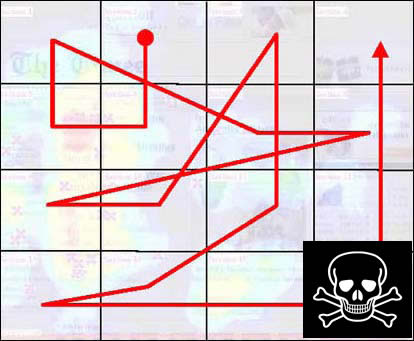Avoid the Corner of Death!
What’s the worst place to put your logo, and where do advertisers most often put their logo in print ads, TV spots, and direct mail pieces? The answer is the same: the lower right corner, an area dubbed the “Corner of Death” by facial coding expert Dan Hill.
Hill’s comments stem from an interesting eyetracking study by Steve Outing and Laura Rule, reported in The Best of Eyetrack III. This illustration shows a composite average of how people scan a typical web page:

Outing and Rule caution against taking this exact path too seriously, as variations in layout will cause differences in how people scan the page. The skull graphic wasn’t part of Outing and Rule’s report, but rather inspired by a similar image in Hill’s new book, About Face.
In an recent article, Hill says:
If we take print ads as an example, you’ve got 1.7 seconds of average viewing time, per reader. And the lower right-hand corner is typically the second to last place people look on a page. (What’s even worse in terms of timing, along the upper right edge, i.e., the alley of death.) What you don’t see, you don’t get. [From Mediapost – The 6 Secrets of Eye-tracking by Dan Hill.]
Despite these findings, the lower right corner is by far the most common single location for the primary logo/brand identity use in all types of advertising, according to Hill.
So based on eye-tracking research, where should the logo or brand identity be placed so that consumers actually see it? Hill says that the best place is the lower middle part of the page or layout, At that point, the viewer will have engaged emotionally with the leading part of the ad, and will then have the opportunity to associate the brand with solving a problem or satisfying consumers’ wants.

